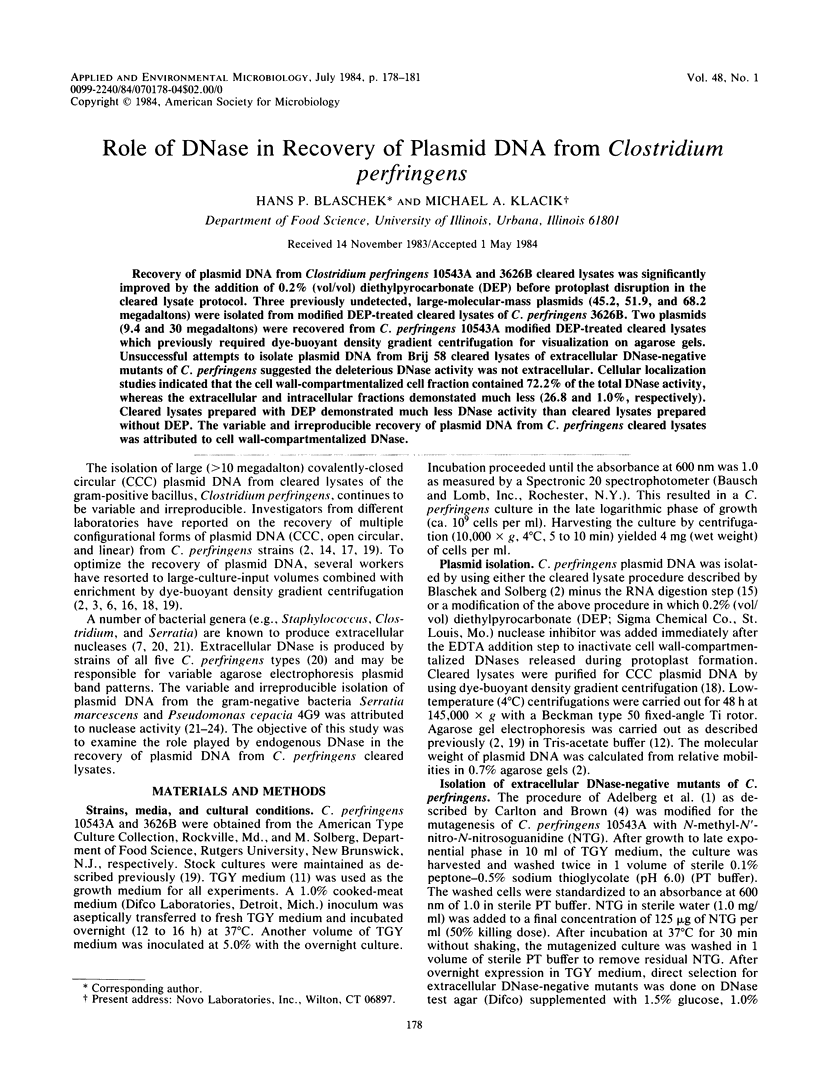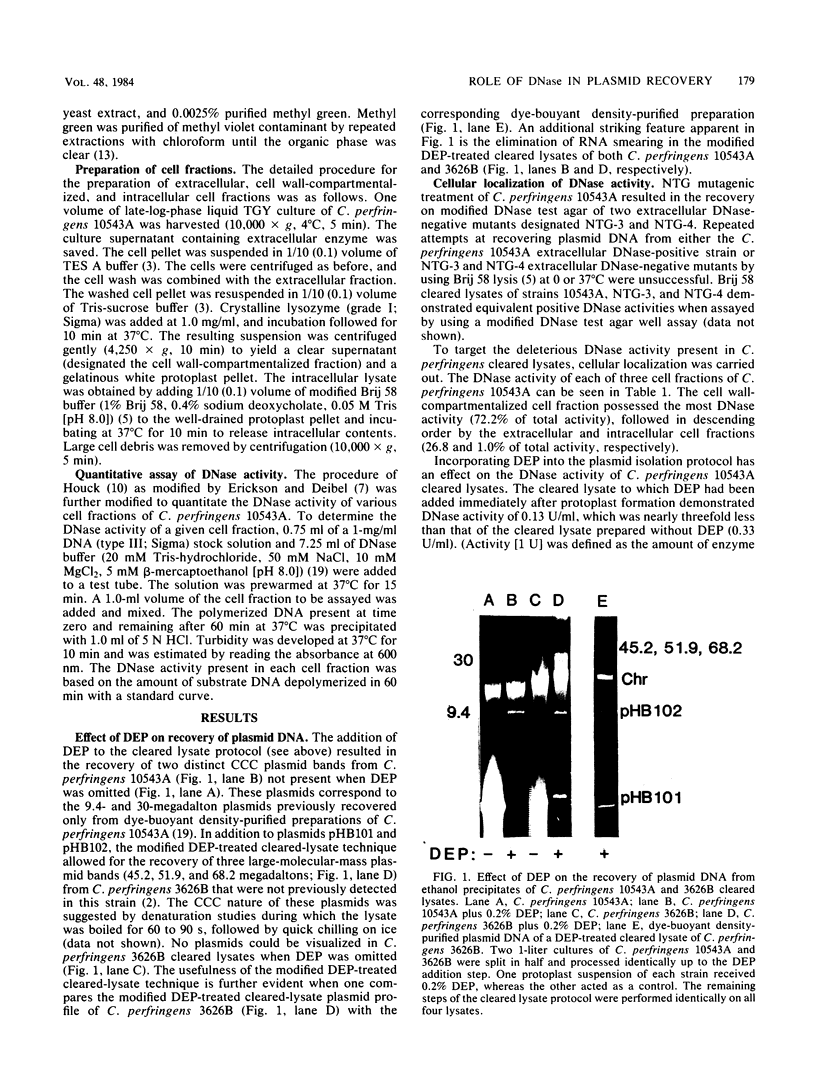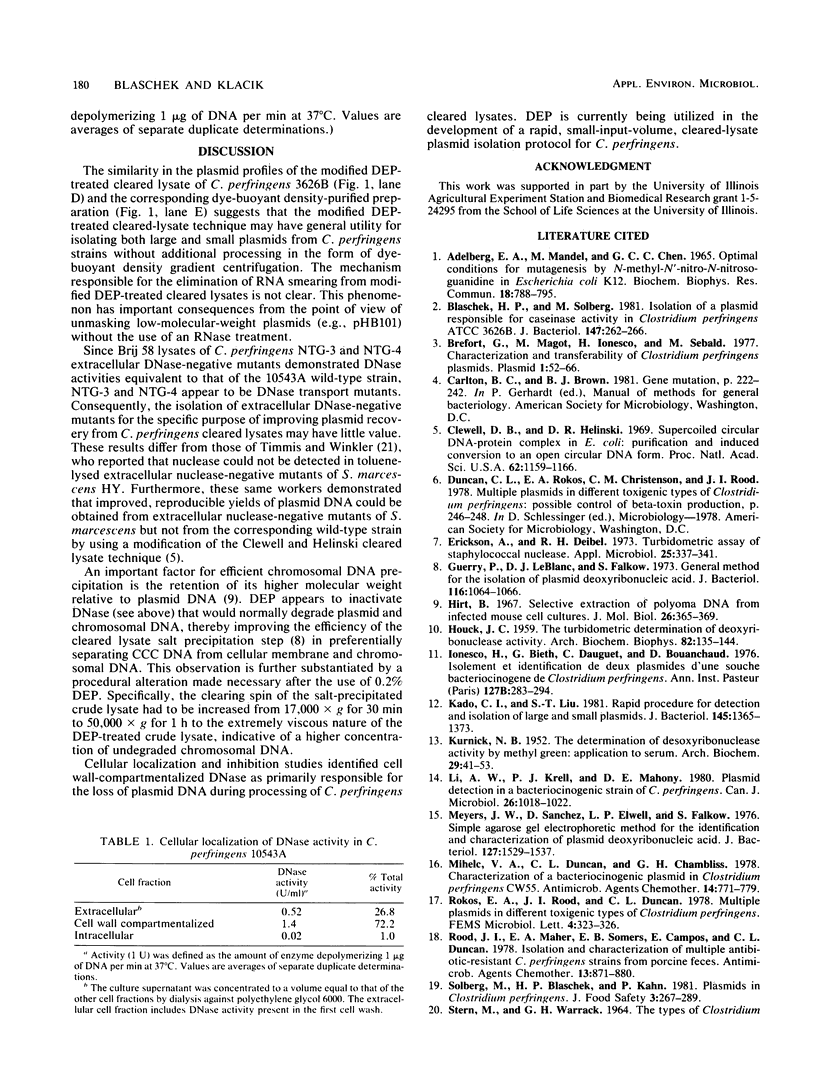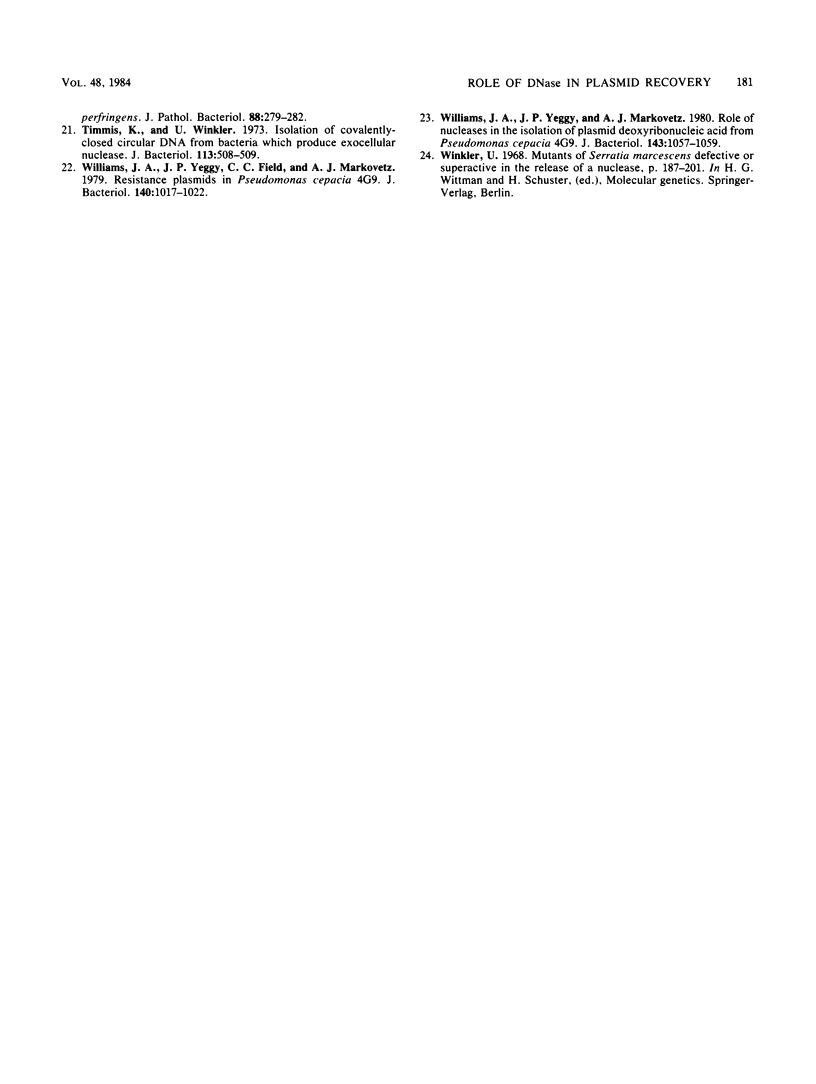Abstract
Recovery of plasmid DNA from Clostridium perfringens 10543A and 3626B cleared lysates was significantly improved by the addition of 0.2% (vol/vol) diethylpyrocarbonate (DEP) before protoplast disruption in the cleared lysate protocol. Three previously undetected, large-molecular-mass plasmids (45.2, 51.9, and 68.2 megadaltons) were isolated from modified DEP-treated cleared lysates of C. perfringens 3626B. Two plasmids (9.4 and 30 megadaltons) were recovered from C. perfringens 10543A modified DEP-treated cleared lysates which previously required dye-buoyant density gradient centrifugation for visualization on agarose gels. Unsuccessful attempts to isolate plasmid DNA from Brij 58 cleared lysates of extracellular DNase-negative mutants of C. perfringens suggested the deleterious DNase activity was not extracellular. Cellular localization studies indicated that the cell wall-compartmentalized cell fraction contained 72.2% of the total DNase activity, whereas the extracellular and intracellular fractions demonstrated much less (26.8 and 1.0%, respectively). Cleared lysates prepared with DEP demonstrated much less DNase activity than cleared lysates prepared without DEP. The variable and irreproducible recovery of plasmid DNA from C. perfringens cleared lysates was attributed to cell wall-compartmentalized DNase.
Full text
PDF



Images in this article
Selected References
These references are in PubMed. This may not be the complete list of references from this article.
- Blaschek H. P., Solberg M. Isolation of a plasmid responsible for caseinase activity in Clostridium perfringens ATCC 3626B. J Bacteriol. 1981 Jul;147(1):262–266. doi: 10.1128/jb.147.1.262-266.1981. [DOI] [PMC free article] [PubMed] [Google Scholar]
- Brefort G., Magot M., Ionesco H., Sebald M. Characterization and transferability of Clostridium perfringens plasmids. Plasmid. 1977 Nov;1(1):52–66. doi: 10.1016/0147-619x(77)90008-7. [DOI] [PubMed] [Google Scholar]
- Clewell D. B., Helinski D. R. Supercoiled circular DNA-protein complex in Escherichia coli: purification and induced conversion to an opern circular DNA form. Proc Natl Acad Sci U S A. 1969 Apr;62(4):1159–1166. doi: 10.1073/pnas.62.4.1159. [DOI] [PMC free article] [PubMed] [Google Scholar]
- Erickson A., Deibel R. H. Turbidimetric assay of staphylococcal nuclease. Appl Microbiol. 1973 Mar;25(3):337–341. doi: 10.1128/am.25.3.337-341.1973. [DOI] [PMC free article] [PubMed] [Google Scholar]
- Guerry P., LeBlanc D. J., Falkow S. General method for the isolation of plasmid deoxyribonucleic acid. J Bacteriol. 1973 Nov;116(2):1064–1066. doi: 10.1128/jb.116.2.1064-1066.1973. [DOI] [PMC free article] [PubMed] [Google Scholar]
- HOUCK J. C. The turbidimetric determination of deoxyribonuclease activity. Arch Biochem Biophys. 1959 May;82(1):135–144. doi: 10.1016/0003-9861(59)90098-0. [DOI] [PubMed] [Google Scholar]
- Hirt B. Selective extraction of polyoma DNA from infected mouse cell cultures. J Mol Biol. 1967 Jun 14;26(2):365–369. doi: 10.1016/0022-2836(67)90307-5. [DOI] [PubMed] [Google Scholar]
- Ionesco H., Bieth G., Dauguet C., Bouanchaud D. Isolement et identification de deux plasmides d'une souche bactériocinogène de Clostridium perfringens. Ann Microbiol (Paris) 1976 Oct;127B(3):283–294. [PubMed] [Google Scholar]
- KURNICK N. B. The determination of desoxyribonuclease activity by methyl green; application to serum. Arch Biochem. 1950 Nov;29(1):41–53. [PubMed] [Google Scholar]
- Kado C. I., Liu S. T. Rapid procedure for detection and isolation of large and small plasmids. J Bacteriol. 1981 Mar;145(3):1365–1373. doi: 10.1128/jb.145.3.1365-1373.1981. [DOI] [PMC free article] [PubMed] [Google Scholar]
- Li A. W., Krell P. J., Mahony D. E. Plasmid detection in a bacteriocinogenic strain of Clostridium perfringens. Can J Microbiol. 1980 Aug;26(8):1018–1022. doi: 10.1139/m80-173. [DOI] [PubMed] [Google Scholar]
- Meyers J. A., Sanchez D., Elwell L. P., Falkow S. Simple agarose gel electrophoretic method for the identification and characterization of plasmid deoxyribonucleic acid. J Bacteriol. 1976 Sep;127(3):1529–1537. doi: 10.1128/jb.127.3.1529-1537.1976. [DOI] [PMC free article] [PubMed] [Google Scholar]
- Mihelc V. A., Duncan C. L., Chambliss G. H. Characterization of a bacteriocinogenic plasmid in Clostridium perfringens CW55. Antimicrob Agents Chemother. 1978 Nov;14(5):771–779. doi: 10.1128/aac.14.5.771. [DOI] [PMC free article] [PubMed] [Google Scholar]
- Rood J. I., Maher E. A., Somers E. B., Campos E., Duncan C. L. Isolation and characterization of multiply antibiotic-resistant Clostridum perfringens strains from porcine feces. Antimicrob Agents Chemother. 1978 May;13(5):871–880. doi: 10.1128/aac.13.5.871. [DOI] [PMC free article] [PubMed] [Google Scholar]
- STERNE M., WARRACK G. H. THE TYPES OF CLOSTRIDIUM PERFRINGENS. J Pathol Bacteriol. 1964 Jul;88:279–283. [PubMed] [Google Scholar]
- Timmis K., Winkler U. Isolation of covalently closed circular deoxyribonucleic acid from bacteria which produce exocellular nuclease. J Bacteriol. 1973 Jan;113(1):508–509. doi: 10.1128/jb.113.1.508-509.1973. [DOI] [PMC free article] [PubMed] [Google Scholar]
- Williams J. A., Yeggy J. P., Field C. C., Markovetz A. J. Resistance plasmids in Pseudomonas cepacia 4G9. J Bacteriol. 1979 Dec;140(3):1017–1022. doi: 10.1128/jb.140.3.1017-1022.1979. [DOI] [PMC free article] [PubMed] [Google Scholar]
- Williams J. A., Yeggy J. P., Markovetz A. J. Role of nucleases in the isolation of plasmid deoxyribonucleic acid from Pseudomonas cepacia 4G9. J Bacteriol. 1980 Aug;143(2):1057–1059. doi: 10.1128/jb.143.2.1057-1059.1980. [DOI] [PMC free article] [PubMed] [Google Scholar]



